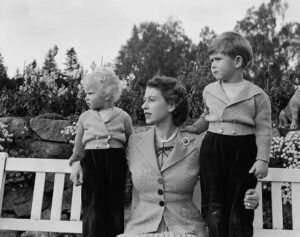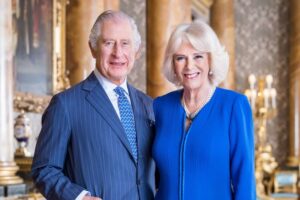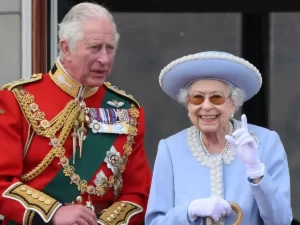Forgotten Friday – The History of Charles III
In honour of the King’s Coronation tomorrow, today’s #ForgottenFriday focuses on his life throughout the years!
Born November 14, 1948, at Buckingham Palace, Prince Charles Philip Arthur George was the first child of Princess Elizabeth and Prince Philip and grandson of King George VI. On 6th February 1952, at the age of three, he became heir-apparent when his mother ascended the throne.

14th November 1952: Queen Elizabeth II with Prince Charles and Princess Anne in the grounds of Balmoral Castle, Scotland. Charles is celebrating his 4th birthday. (Photo by Lisa Sheridan/Studio Lisa/Hulton Archive/Getty Images)
According to Royal.uk, the official website of the British Royal Family, Charles’ parents chose to send him to school, making him the first heir to receive an outside education, rather than one from private tutors. He attended several schools, including a private boarding school in Scotland, and two terms as an exchange student in Melbourne.
Charles was also the first heir to the British crown to earn a bachelor’s degree, attending Trinity College, at Cambridge University from 1967-1970. He studied archaeology, anthropology and, eventually, history. It was during this time, in 1969, that, at age 20, he was titled Prince of Wales.
Following in the footsteps of his father, grandfather and great-grandfathers, Charles served in the Royal Navy from 1971-1976 where he flew helicopters, first training as a Royal Air Force pilot and eventually serving as commander of the minesweeper the HMS Bronington.
Charles began dating Lady Diana Spencer in 1980 when she was 19 and he was 31. Charles had met Diana three years earlier while dating her older sister, Sarah. In February 1981, their engagement was announced, causing a media frenzy over their relationship.
They were married on July 29, 1981, at St. Paul’s Cathedral in a ceremony witnessed by a record-breaking 750 million TV viewers across the globe. The day was declared a national holiday in Great Britain. Diana became the first English woman since 1660 to marry an heir to the throne.
The couple’s first son, Prince William, was born June 21, 1982, and Prince Harry was born two years later on September 15, 1984.
Beloved by the public for her beauty, grace and humanitarian work that included working with HIV/AIDS and leprosy patients and advocating for landmine removal and homelessness causes, Diana had the support of the public when the couple separated in 1992. This became especially true following Charles’s admission that he had engaged in a long-running affair with Camilla Parker Bowles during a 1994 interview. “There were three of us in this marriage,” Diana later responded. Charles and Diana divorced in 1996. Tragically, on August 31, 1997, Diana was killed in a car wreck in Paris, along with her companion, Dodi Al-Fayed and driver, Henri Paul.
In 2004, Charles and Camilla announced their engagement, and wed the next year with Camilla given the title Duchess of Cornwall.
When Queen Elizabeth died at age 96 after serving as Britain’s longest-serving monarch on September 8, 2022, Charles immediately became king, with an official proclamation taking place on 10th September.
“My mother gave an example of lifelong love and of selfless service,” he told the Assession Council. “Even as we grieve, we give thanks for this most faithful life. I am deeply aware of this great inheritance and of the duties and heavy responsibilities of sovereignty which have now passed to me.”
With Charles’s ascension, his son William inherited his father’s former title, Prince of Wales and became the heir to the throne. Camilla’s title changed to Queen Consort. Charles has five grandchildren: Prince George (next in line to the crown after William), Princess Charlotte and Prince Louie, all born to Prince William and Kate Middleton; and Archie and Lilibet, children of Prince Harry and Meghan Markle.

The kings Coronation will take place tomorrow and will be a national bank holiday!
CC. Read more here – https://www.history.com/topics/european-history/king-charles-iii

